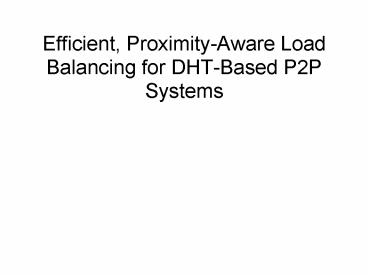Efficient, ProximityAware Load Balancing for DHTBased P2P Systems - PowerPoint PPT Presentation
Title:
Efficient, ProximityAware Load Balancing for DHTBased P2P Systems
Description:
Gaussian Distribution, Gnutella-like Capacity. Pareto Distribution, Zipf-like Capacity ... Gnutella. Pareto/Zipf. Proximity 'ts5k-small' Gaussian/Gnutella ... – PowerPoint PPT presentation
Number of Views:30
Avg rating:3.0/5.0
Title: Efficient, ProximityAware Load Balancing for DHTBased P2P Systems
1
Efficient, Proximity-Aware Load Balancing for
DHT-Based P2P Systems
2
Motivations
- DHT's offer uniform distribution
- But resources on servers are not uniform
- Ignores heterogeneous nature of P2P systems
- Previous load-balancing techniques
- Ignored heterogeneity
- Ignored proximity
- Sometimes both
3
Goals
- Achieve load balance by allowing nodes with
higher capacity to be responsible for more load - Use proximity to assign load (in terms of virtual
servers) in order to minimize transfer time - Perform load assignments and load transfer in an
efficient manner
4
Overview of System
- Four phases
- Load balancing information (LBI) aggregation
- Node classification
- Virtual server assignment
- Virtual server transfer
5
Distributed Tree
- LBI distribution is performed by building a
distributed k-ary tree - Each node is responsible for a space of the DHT
- Each node is stored on the virtual server
responsible for the center of the region for
which the node is responsible - This region is further divided until the host of
a node completely covers the node's region
6
Tree Functions
- Each node performs routine functions to maintain
its state - check_KT_node
- delete_KT_children
- add_KT_children
7
LBI Aggregation
- Each node requests LBI from its children
- If it is a leaf-node, then it asks its virtual
server to report the LBI - LBI ltTotal Load, Total Capacity, Min. Loadgt
- This LBI is propagated up the tree
- The root contains the system-wide LBI
- The system-wide LBI is sent back down the tree
8
Node Classification
- Target load (L/C e)Ci
- Node classification
- Heavy if Load gt Target load
- Light if (Target - Load) gt Minimum load
- Neutral if 0 lt (Target Load) lt Minimum load
9
Virtual Server Assignment
- Heavy node
- Chooses a minimal subset of its virtual servers
that need to be moved in order to make the server
light - Reports this information to host node
- Light node
- Reports change in load necessary to reach target
load
10
Virtual Server Assignment
- VSA information is collected into a pool
- If pool reaches a threshold, the current node
will perform the virtual server assignments - The assignments are given to children
- Remaining VSA information is propagated to host
11
Virtual Server Transfer
- Heavy node receives transfer information
- Virtual server is transferred
- Tree is restructured after transfer
- VSA and VST can overlap
12
Proximity
- Oops what happened to proximity?
- Current DHT is proximity-ignorant
- We need to add proximity information
- How?
13
Adding Proximity
- Use proximity to produce DHT keys
- Use landmark nodes to find proximity
- Use space-filling curves to map m-dimensional
space vector to 1-dimensional key - VSA information is first mapped into this DHT
- VSA information is now mapped into physically
close locations
14
Gaussian Distribution, Gnutella-like Capacity
15
Pareto Distribution, Zipf-like Capacity
16
Proximity ts5k-large
Pareto/Zipf
Gaussian/Gnutella
17
Proximity ts5k-small
Pareto/Zipf
Gaussian/Gnutella































